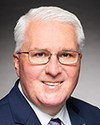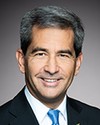Madam Speaker, I am very pleased to have the opportunity to rise and join in this important debate, in part because of its timeliness, given the apparent winding down of combat activity against Daesh and the ongoing evolution of terrorist threats in this country. It is also because the myths and misperceptions that have been allowed to persist in this House over the last few weeks have misinformed Canadians. Not surprisingly, those misperceptions are now echoed at family dinner tables right across the country.
If the quality of recent debate is to be believed, Canadians would think that we are combatting returning terrorists with poetry. However, Canadians expect to know exactly what their government does to protect their safety without the distraction of irresponsible sound bites. Therefore, I will dispel some of these myths.
First of all, how are returning extremists treated? The idea persists that they are somehow akin to prisoners at the end of their sentence, being reintegrated into the community, which is certainly not the case. Canada's law enforcement, security, and intelligence departments and agencies actively assess and monitor the threat each individual poses. They may be charged with a criminal offence where the evidence warrants. Based on available information, they may have passports revoked. They may be denied travel or placed on Canada's no-fly list. They are monitored closely in every case, and their return is tightly controlled and managed. In some cases, they may be found suitable for programs designed to help disengage from violent extremism, but by no means does that replace, prevent, or exclude investigation and close monitoring.
Second, the myth persists that somehow we can and should paint each returning extremist with the same brush through immediate action. However, we cannot, and we should not. Threat assessment is made to measure. Their places of travel, experience, and motivations may be entirely different. Criminal investigations are unique from case to case, and these, I can say from experience, can take time. They take a herculean effort on the part of many agencies in collaboration with international allies.
Third, there is a myth that our security agencies cannot possibly keep tabs on each and every returning extremist, which is also untrue. There are approximately 60 who have returned to Canada, and that is over the past decade. This has not changed significantly over the years. The full range of counterterrorism tools are in use, including surveillance, monitoring, and ongoing investigations. Once they return, agencies are well aware of them and aware of appropriately managing the threat they present to our citizens.
Fourth, there is a perception that these returnees pose Canada's largest security threat. This is also an unfortunate mischaracterization. Let us remember that the Strathroy and Saint-Jean-sur-Richelieu attacks in Canada were made by homegrown terrorists. They never left the country. They were radicalized right here in Canada. The same goes for attacks in Berlin and Nice. Those terrorists had not been trained in Syria or Iraq, but fought from their home countries, inspired by groups like Daesh. The risks that homegrown terrorists pose can be just as great as those posed by returning extremists.
There is no neat and simple solution to the complex problem that terrorism poses in a rapidly changing world, but we have in place effective and world-class professionals. Canada's full range of counterterrorism tools are in use, and these include ongoing investigations, surveillance and monitoring, intelligence gathering and sharing, the collection of criminal evidence, criminal charges, and prosecution where the evidence exists. Other Criminal Code tools, like peace bonds, public listings, expert threat assessments, no-fly lists, the revocation of passports, and legally authorized threat destruction measures, are all in use. The government and Canada's top-notch security agencies continue to use all the tools at their disposal to address the threat of Canadians joining or returning from terrorist activities.
The National Security Joint Operations Centre helps to coordinate an effective and timely operational response to high-risk travellers. G7 interior ministers recently redoubled their commitment to sharing information and working closely together to deal with returning extremists, and the process has worked.
We must now focus our attention on what lies ahead. Daesh, for one, continues to aggressively target the Internet to push an evil ideology and to recruit new adherents. Those who were on the battlefield may now be attempting to move perhaps to Africa, Asia, or Europe, and even to Canada. Yet, as the Minister of Public Safety and Emergency Preparedness has said, the terror threat is now morphing into other forms, and we must not be complacent.
As I have noted, homegrown terrorism is one of our most urgent threats. It can come in many forms, from right- and left-wing extremism to religious motivations.
In Bill C-59, the overhaul of national security legislation currently at committee, we intend to provide the framework through which we can act on these threats, moving forward. We need to play the long game. International experts recognize that a key part of that means getting to the roots of the problems on our own turf, and that is why the government recently launched a new centre to coordinate, bolster, and help fund and share the counter-radicalization programming that exists across the country. It is called the Canada Centre for Community Engagement and Prevention of Violence. It is based on the fact that early intervention in dangerous situations to prevent radicalization to violence can and does work. The centre takes a broad approach to this issue, recognizing that the process of radicalization to violence occurs differently for different people.
It provides national leadership to support local efforts, and a key part of that work is through the community resilience fund. This fund was created to enhance those partnerships and to promote innovation in research on countering radicalization to violence, and domestic programming. We have recently announced a renewed call for proposals under this fund, with $1.4 million available to approved projects starting in 2018 and $7 million annually for the balance of the program. The centre is ensuring that resources are in place to facilitate disengagement from violent ideologies. In particular, children are served who return from combat zones and require tailored support to recover from their traumatic experiences.
From every angle, the Government of Canada continues to carefully monitor trends in extremist travel, and our national security agencies work extremely well together to ensure our response reflects the current threat environment. Canadians can be assured that our agencies are carefully monitoring returning extremists and that our law enforcement agencies are doing the difficult work of collecting the evidence required for convictions in Canadian courts. This remains a priority for our government and for all of our national security agencies. We must work together, alert at all times to the threats posed by terrorism at all levels, buoyed by solid facts and a shared commitment to act.











